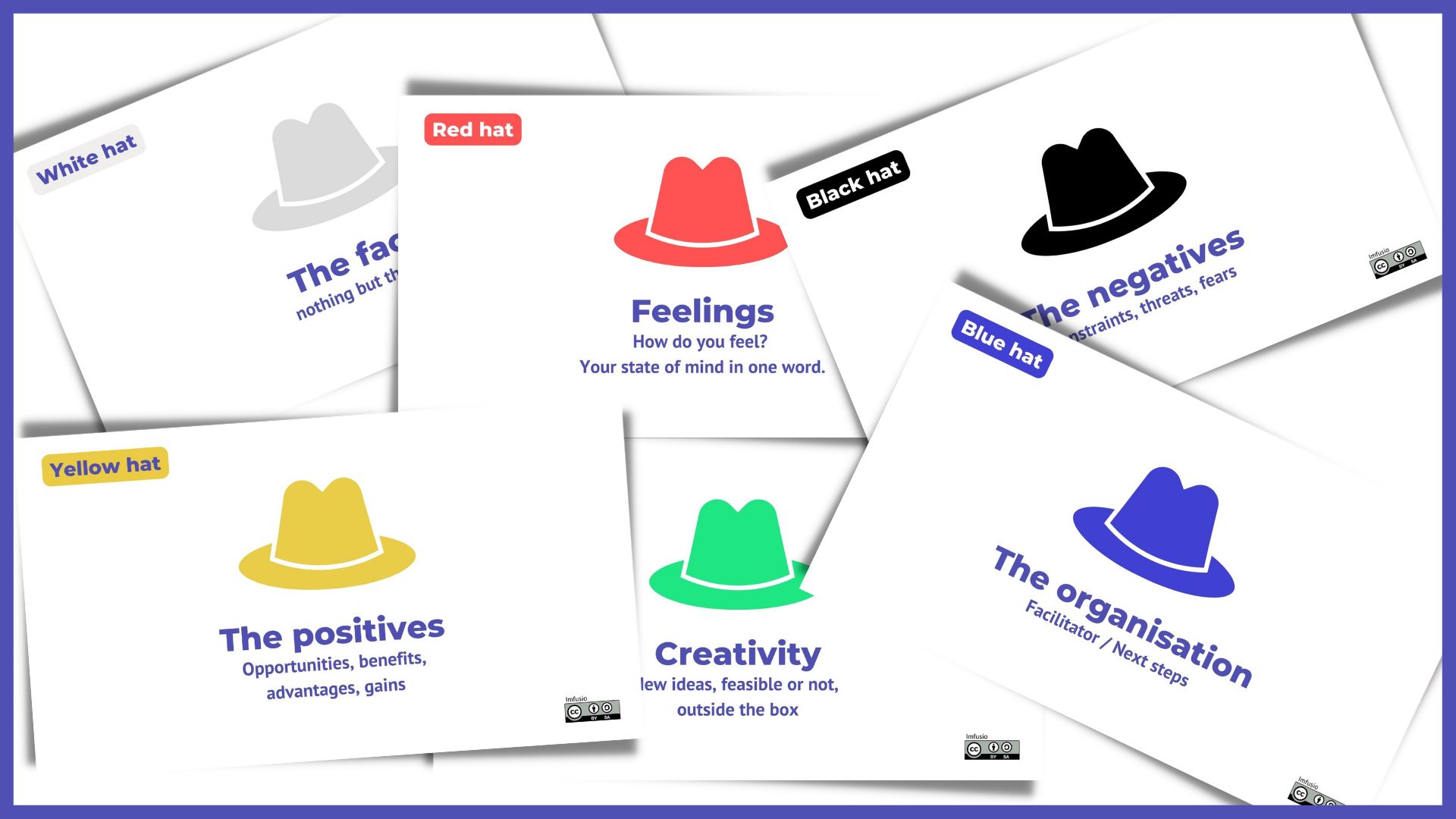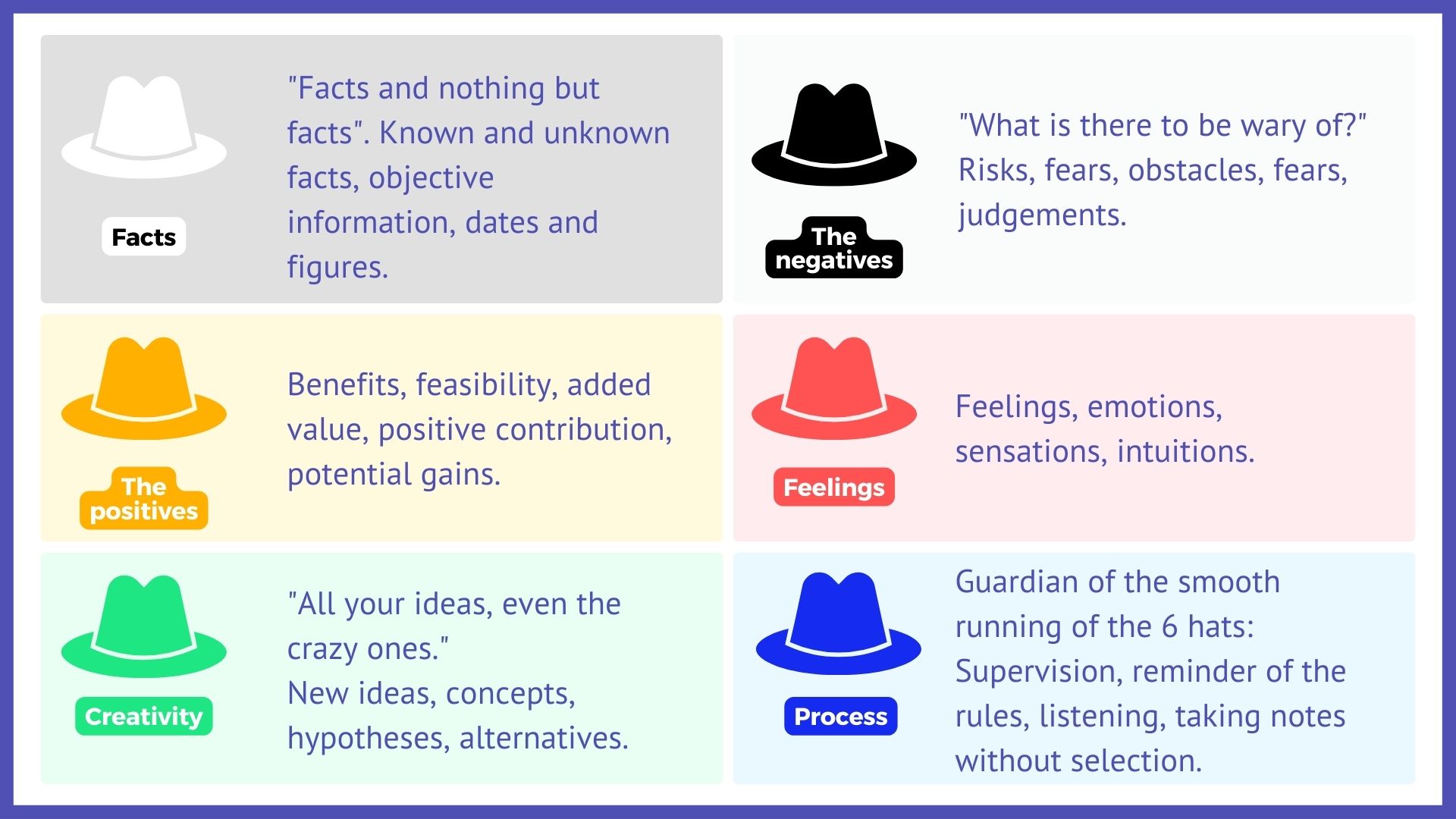To save colors and take care of the planet, print this text in shades of gray
Bono’s Six Thinking Hats
Get the most out of group work by aligning different ways of thinking
Pratique
Aim
This structured brainstorming method enables you to get the full potential out of all forms of thinking (factual, emotional, creative, etc.) in order to benefit innovation and creativity.
Invented by Doctor Edward de Bono in 1987, this methodology aims to establish shared, parallel thinking: instead of mixing all types of thought like we do on a daily basis in our unstructured thought processes, the group tries to separate them by imagining they are wearing the corresponding “hat”.
Six different ways of looking at things (process, facts, negative, positive, emotional and creative) are symbolised by six different coloured hats, which the participants try on one by one.
All members of the group all use the same type of thinking at the same time. They feed each other’s ideas and convergence becomes much easier.
Edward de Bono and creative thinking:
Intructions
Time needed: 20 to 45 minutes
Materials
- 6 posters describing each hat
- 6 blank sheets of paper (1 per hat) or one large flip chart
- Something to write with

As facilitator, you wear the “blue hat” throughout the entire process: you don’t take part in the discussion, but make sure that the group are using the correct thinking type.
You can also fulfil the role of scribe: take note of all the discussions and ideas that come up during the session. Don’t filter them! If you need to divide the group into several smaller groups, the role of scribe is assumed by one member of each sub-group.
Each hat corresponds to one single form of thinking, which all participants must adopt for one single round. The rounds are deliberately short (2 to 5 minutes maximum) to facilitate a spontaneous “straight-off-the-beat” dynamic. With the green hat, it can sometimes take a bit longer to cover all the ideas, even the craziest! (5 to 15 mins).
Key steps

- Blue hat: process
As wearer of the blue hat and therefore controller of the process, you must start by presenting the problem that the group will be working on, the context, the aim of the workshop and how the session will work (origin and benefits of the method, roles of each hat, order and timings). - White hat: facts
Ask the group to state facts that relate to the problem: what do they know about the situation, what information do they have, what figures to they have, what are the related standards, what information do they need, etc. - Black hat: the negatives
Ask the group to see the situation with a “glass half empty” approach: what is slowing each situation down, what are the disadvantages, what’s missing, what are the potential obstacles, etc. - Yellow hat: the positives
Now ask them to reflect on the problem in terms of advantages, opportunities, benefits and even dreams. - Red hat: feelings
Ask each participant to express how they feel in relation to the problem, without justifying it: whatever their intuition tells them, what does it inspire them to do, what are their beliefs, what feelings arise, etc. - Green hat: creativity
Now that they have looked at the problem from all angles, ask the participants to respond to it: all ideas are good ideas, whether they are realistic or not! - Blue hat: convergence
With the help of the whole group, separate the ideas into themes and wrap up the session: what to take away from it, what solution are they going to work towards, what are the next steps, etc. You can also split the participants into project groups to reflect on the advantages and disadvantages of each idea if you want them to get working on them straight away.
Example.
For the following topic: Nature & Découvertes flavours. Below are the types of questions that you could prepare in advance:
- White hat: What do we know about N&D’s flavours? What do we not know?
- Black hat: What are the restrictions and obstacles related to this range? For N&D, for the consumer, etc.
- Yellow hat: What are the benefits and opportunities related to this range?
- Red hat: Think of one word that describes your state of mind, your intuition, right now, in relation to the topic.
- Green hat: Ask an inspiring question that starts with “How…” How can we make the range of N&D flavours a source of pleasure for the consumer?
Tips and advice
- When you get to the yellow hat, feel free to give the group a bit of encouragement: our brains generally find it more difficult to only see the positives. It’s important to encourage them to get out of the habit of “yes but…”
- If you feel that it’s necessary, you can go back over some of the hats. For example, if lots of fears and worries came out of the red hat, you can go back to the black and yellow hats for a sort of “purge”, before moving on to green.
- Make sure you keep up the pace, i.e. get them to come up with as many ideas as possible without censorship: statistically, the more ideas you come up with, the more chance you have of finding the right one.
- Remind the group to save debates for the idea sorting phase after the green hat, not before!
- The order of the black, yellow and red hats can be switched around depending on the nature of the problem, the group culture and the aim of the task.